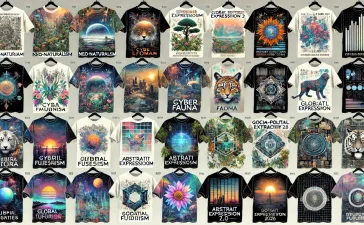As an art licensing agency, ArtSHINE has recently seen a surge in emerging brands seeking representation for licensing their intellectual property (IP). While globally recognized brands like Disney or Coca-Cola have established credibility, emerging brands must navigate a more complex path to achieve successful brand licensing. Here’s a comprehensive guide on what these brands need to do to prepare for licensing and what we, as agents, look for in potential clients.
Step 1: Develop a Strong Brand Identity
Tip: Establish a clear, distinctive brand identity. This includes a compelling brand story, unique value propositions, and consistent visual and verbal elements (logos, slogans, and color schemes). Your brand should communicate a clear message and evoke a specific feeling or association that differentiates it from competitors.
Example: If you are a brand focusing on sustainable fashion, ensure that your brand identity reflects eco-friendly practices, ethical sourcing, and a commitment to environmental sustainability. This consistency helps in building trust and recognition among consumers and potential licensees.
Step 2: Build a Solid Portfolio
Tip: Create a comprehensive portfolio showcasing your brand’s products, designs, and any successful case studies or collaborations. This portfolio should demonstrate the versatility and appeal of your brand across different mediums and products.
Example: Include high-quality images of your products, detailed descriptions, and any testimonials or reviews. If you have collaborated with other brands or influencers, highlight these partnerships to show your brand’s potential and market acceptance.
Step 3: Protect Your Intellectual Property
Tip: Ensure that all aspects of your brand, including logos, slogans, designs, and unique products, are protected under intellectual property laws. This may involve registering trademarks, copyrights, and patents as necessary.
Example: Work with a legal expert to file for trademarks and copyrights. This not only protects your brand from infringement but also increases its value and appeal to potential licensees.
Step 4: Research Potential Licensees
Tip: Identify companies and industries that align with your brand values and have a target audience that matches yours. Conduct thorough research to understand their product lines, market reach, and licensing history.
Example: If your brand focuses on luxury home décor, target companies in the home furnishings and interior design industries. Look for companies that have successfully licensed similar brands and have a strong distribution network.
Step 5: Develop a Licensing Strategy
Tip: Create a detailed licensing strategy that outlines your goals, target markets, and potential licensees. This strategy should include pricing models, royalty rates, and contractual terms.
Example: Determine whether you want to pursue exclusive or non-exclusive licensing agreements. Set clear guidelines for royalty percentages and minimum sales targets to ensure that your brand is effectively monetized.
Step 6: Create a Compelling Licensing Presentation
Tip: Prepare a professional licensing presentation that clearly communicates the benefits of partnering with your brand. This presentation should include your brand story, portfolio, market research, and licensing strategy.
Example: Use visual aids such as slideshows and videos to make your presentation engaging. Highlight your brand’s unique selling points and how they can benefit the potential licensee’s product lines and market presence.
Step 7: Network and Pitch to Potential Licensees
Tip: Attend industry trade shows, networking events, and business conferences to meet potential licensees. Use these opportunities to pitch your brand and establish connections.
Example: Prepare elevator pitches and have your licensing presentation ready for quick discussions. Follow up with interested parties promptly and provide them with detailed information about your brand and licensing opportunities.
Step 8: Negotiate and Finalize Licensing Agreements
Tip: Engage in negotiations with potential licensees to finalize licensing agreements. Be prepared to discuss terms such as royalty rates, contract duration, exclusivity, and marketing commitments.
Example: Work with a legal advisor to ensure that the terms are fair and protect your brand’s interests. Clearly define the responsibilities of both parties to avoid misunderstandings and disputes.
What ArtSHINE Looks For in Potential Licensing Clients
As an art licensing agency, ArtSHINE seeks brands with strong potential for growth and market impact. Here’s what we look for:
- Unique and Distinctive Brand Identity: We seek brands that have a clear, unique identity that stands out in the market. This includes a compelling brand story and consistent visual and verbal elements.
- Market Potential: Brands should demonstrate a strong understanding of their target market and show evidence of demand for their products or designs.
- Quality and Versatility: We look for high-quality products and designs that can be adapted across various mediums and products. Versatility increases the chances of successful licensing partnerships.
- Protected Intellectual Property: Ensuring that the brand’s IP is legally protected is crucial. This not only safeguards the brand but also makes it more attractive to potential licensees.
- Professionalism and Preparedness: Brands should be well-prepared with a comprehensive portfolio, licensing strategy, and compelling presentation. Professionalism in these areas indicates readiness for successful licensing.
Conclusion
Brand licensing can be a powerful strategy for emerging brands to expand their market presence and revenue streams. By developing a strong brand identity, building a solid portfolio, protecting intellectual property, and engaging in strategic networking and negotiations, brands can successfully navigate the licensing landscape. At ArtSHINE, we are committed to helping our clients achieve their licensing goals and grow their brands through strategic partnerships and expert guidance.
Want to learn more? We’re here to help you to take action, just like we’ve helped thousands of other entrepreneurs, business owners, and creative professionals all around the globe. Now is the time to let your passion SHINE. Now is the time to Make Tomorrow Today! To your success, Vinh Van Lam and Stuart Horrex Cofounders
ArtSHINE.com





